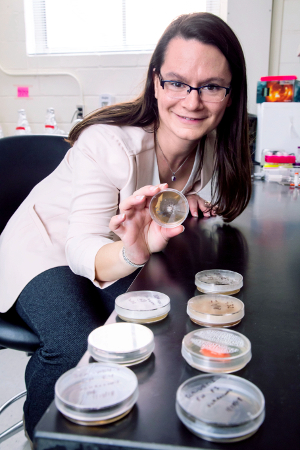Tiny Organisms, Huge Possibilities
By Ana Luiza Mees
Researchers across Duke University are working to harness the power of microbiomes in many different arenas

As the global population rises, laboratories across the world are working to develop methods to reduce human impact on the environment. At Duke University, Claudia Gunsch, the Theodore Kennedy Associate Professor of Civil and Environmental Engineering and director of IBIEM (Integrative Bioinformatics for Investigating and Engineering Microbiomes), an interdisciplinary graduate training program, currently leads cutting-edge research that unites biology, genomics and bioinformatics to tackle problems like pollution.
Gunsch began her research as an undergraduate student. After taking her first microbiology class, she became fascinated with the field’s unpredictable nature. As an undergraduate, she spent hours doing biological research in laboratories before dedicating her time to studying pollutant-degrading microbes as a graduate researcher.
 In Gunsch’s laboratories today, graduate and undergraduate students sequence microbe genomes and modify them by transferring useful genes to other species already thriving in target habitats. By finding ways to stimulate the desired species’ activities, it is possible to increase their rates of bioremediation—the process of using living organisms to neutralize or remove contaminants from a certain environment.
In Gunsch’s laboratories today, graduate and undergraduate students sequence microbe genomes and modify them by transferring useful genes to other species already thriving in target habitats. By finding ways to stimulate the desired species’ activities, it is possible to increase their rates of bioremediation—the process of using living organisms to neutralize or remove contaminants from a certain environment.
The researchers are also trying to understand how microbes collaborate, which could explain beneficial and harmful adaptations, such as antibiotic resistance. Because the surge in antibiotic-resistant bacteria has resulted in illnesses that are untreatable with available resources, this is one of the most urgent threats to public health.
After decades of studying microbiomes—highly structured communities of microorganisms—Gunsch demonstrates optimism for the future of her field by saying, “In the past, I would take two years or more to identify a single gene related to the degradation of a pollutant. Now, with new technology available such as machine learning and computation, scientists are able to work at a much faster pace.”
Other researchers at Duke University are studying microbiomes to improve people’s lives and the environment. For example, Lawrence David, assistant professor of molecular genetics and microbiology in the Duke Center for Genomic and Computational Biology, guides a research group that focuses on understanding how diet can be used to shape human-associated microbial communities.
To pursue their nutrition work, David’s research group combines device development, microbial ecology, gene sequencing and computational analysis. His group is currently exploring the effects of over-the-counter nutritional supplements in both health and disease.
Another example of Duke researchers working with microbiomes is Adela Rambi Cardones, associate professor of dermatology at the Duke University School of Medicine, who leads a research group that is interested in understanding how alterations in cutaneous microbial flora and the associated human immune response promotes autoimmune disorders.
When people restrict their thoughts on microorganisms to the human variety, they forget about the fascinating and complex environmental microbiomes located everywhere from the soil to the air to a table surface. Researchers at Duke University aspire to gain a better understanding of both environmental and human microbiomes, like how they interact, what controls them and what they affect. This could lead to impressive outcomes and discoveries.
Ana Luiza Mees is a first-year student expecting to double major in electrical and computer engineering and computer science.
